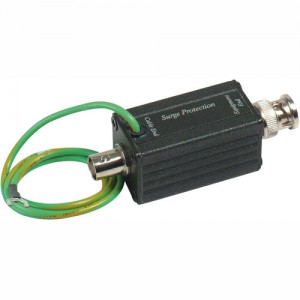 Although the cable used for digital video security systems does not carry a high voltage charge, coax surge protection is still required to protect your system from lightening and even overzealous power outages, and power surges. If a surge makes its way to the camera or to the DVR your system could be destroyed.
Although the cable used for digital video security systems does not carry a high voltage charge, coax surge protection is still required to protect your system from lightening and even overzealous power outages, and power surges. If a surge makes its way to the camera or to the DVR your system could be destroyed.
While power outages and other non-lightening power surges are highly irregular for digital video security camera systems, coax surge protection is needed much more often, especially if you have outdoor cameras that could be a target for a random lightening bolt hit.
There are basically two types of cable that are used for digital camera security systems (there are more but these have got to be the most popular), RG-59 coaxial cable and for the newer technology, PoE (Power over the Ethernet). Both of these are subject to power surges so you can see that there is more than just coax surge protection to think about.
RG-59 coaxial cable normally uses BNC type connectors. RG-59 coaxial cable consists of a center conductor (usually pure copper) with a type of dielectric plastic around it. Around the dielectric plastic is a braided shield type wire, and lastly the outer plenum or PVC jacket to protect the cable from normal wear and tear. With all of this dielectric insulation (“dielectric” basically means non-electrical conducting), the coax cable is able to conduct the radio frequency without much interference coming from within the cable or outside the cable.
However, if the voltage and amperage is high enough, dielectric breakdown could possibly occur. Dielectric break down is when the material between the metal core and shield takes on such an enormous energy surge like a lightening hit, that the dielectric material conducts electricity anyway. In addition to the material that normally doesn’t pass a charge now conducting, the surge can go either or both ways on the outside cable, frying your camera at one end and your DVR at the other.
Telephones, cable television, and many other electric services have a box outside or inside the house with a ground wire attached. The ground wire runs through a wall to the outside where a ground rod (a solid copper rod about 6 feet in length) has been placed (driven with a hammer) directly into the ground. If the home does not have this grounding scheme it should have one similar to it such as a ground box or other device. Even a cold water pipe makes an acceptable ground.
At any rate, the grounded connection is the objective of any surge suppressor. The surge suppressor creates a path for the lightening to go that has little resistance (electricity follows the path of least resistance) safely keeping the lightening from damaging the equipment.
There are two different types of coax surge protection; the gas tube and solid-state. Both types of technologies conduct electricity once a device-rated voltage is found across its terminals and immediately create a low-resistance path to ground. Remember that electricity follows the path of least resistance so this low resistance path discharges the excess electricity to ground and at the same time reducing the potential voltage spike to near zero volts. This is the course of the solid-state surge suppressor.
The gas tube has ionizable gas that is used to achieve the same sort of action as solid-state thus, achieving similar protection.
Security Camera King suggests that, especially if the cable runs outside, you use their coax surge protection (Product# SP-01) at each cable end. The surge protector comes with the BNC ends for hooking it up to the cable and ground wire that can be connected directly to the ground wire in an electrical outlet or to the screw that holds the faceplate on the outlet.
If you would like to see the coax surge protector look under “Security Equipment>Security Camera Accessories>Security Camera Surge Protection.” Here is the exact Web site location: https://www.securitycameraking.com/security-camera-surge-protection-187-ctg.html
If you still have questions about coax surge protection, contact one of our security experts via on-line “Live Chat” or via telephone at 866-573-8878 Monday through Friday from 9AM to 6PM EST.
